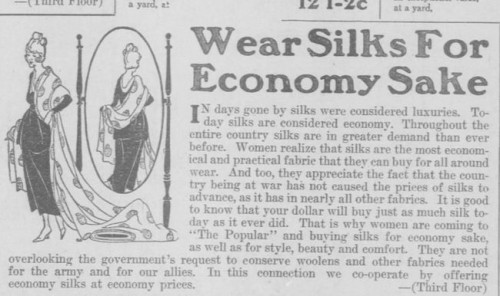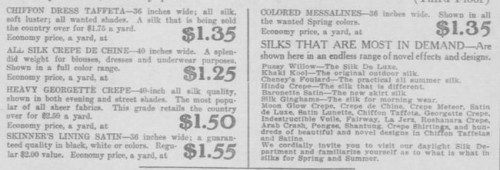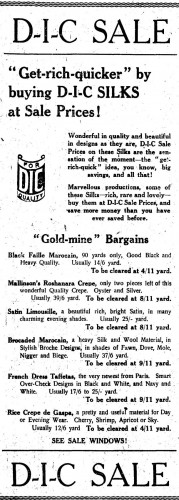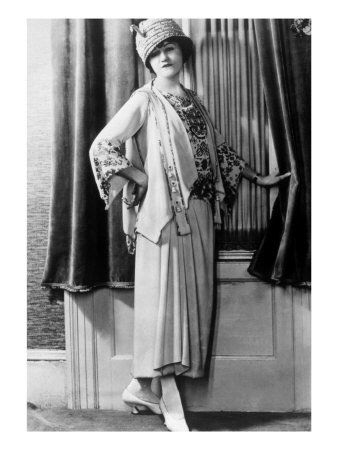Roshanara is the trade name for a silk or silk-worsted wool blend fabric with a rough crepe texture. Roshanara was popular in the 20s and 30s, but was notorious for shrinking when wet. It is nearly impossible to find Roshanara, or a Roshanara equivalent, today.
Roshanara was first introduced into New Zealand in 1920, but appears in ads in the US from 1918. The name probably comes from the famous Roshanara Club in Delhi, which was in turn named after the Mughal princess Roshanara Begum.

El Paso Herald, June 26, 1920, skirts in ‘expensive high-grade silks’, including roshanara & kumsi-kumsa, both launched in NZ in 1920
While Roshanara was primarily made of silk (possibly with a small amount of wool), it was meant to replace wool fabrics, which were in short supply due to the use of wool in soldiers uniforms during WWI. This ad from an April 1918 El Paso Herald extolls the economic virtues of silk, and encourages women to buy it instead of wool. Note the inclusion of the very patriotic and military inspired ‘Khaki Kool’ fabric.

El Paso Herald, Sat 13 April, 1918 via Texas History

El Paso Herald, April 13, 1918 via Texas History
The exotic rough texture of Roshanara, and how closely its introduction co-oincided with the discovery of Tutankhamen’s tomb in 1922, let to its popularity in Egyptianist fashions, like the two below. Isn’t the snake-basket hat on the first fabulously ridiculous?
Roshanara was never more than a novelty fabric, and the small niche it had filled as a wool-replacement in WWI was invalidated by the demand for silk parachutes due to the importance of air forces in WWII.

An ad for a sale including Roshanara crepe, Evening Post, 8 July 1926 via Papers Past



Another ‘new to me’ fabric! Thank you, Dreamstress.
I can see why it disappeared – very much ‘dry clean only’. Just how common were dry-cleaners at the time?
I think dry cleaning for most people in the 20s and 30s involved vinegar or (worse yet) kerosene. I’ve got an Aunt Daisy household guide from the early 1940s, and it has instructions for cleaning suits with a brush and vinegar. It’s pretty clear that the suit would never be washed or cleaned professionally.
The professional dry cleaners were on the go then, I’m just not sure how many there were around. Aunt Daisy’s hints would be for maintenance and spot removal between cleans, which may well have happened only a couple of times a year for men’s suits. (I know that even when I was at school in the 1950s and 60s, the dreaded dark navy serge gym frock was only dry cleaned once a year – but the spot cleans and pressings happened every Sunday!) I Googled ‘dry cleaners Christchurch 1920’ and came up with these people…
http://paperspast.natlib.govt.nz/cgi-bin/paperspast?a=d&d=MEX19200712.2.2.2 … who were established in 1890.
I’d heard of Roshanara (and its practical limitations) and wondered exactly what it was. Thanks for enlightening me.
Silk isn’t exactly economy now a days is it?
I guess that depends on where you are. It’s still cheaper per metre than the average quilting cotton in NZ, and quality for quality it’s the same price as cotton (you can buy cheap, nasty cottons for less, while there are no cheap, nasty silks, but if you want a nice to wear even weave of either you’ll be paying the same price), and cheaper than good wools.
I’d never heard of roshanara until now either. Thanks for the very educational posting.
I’ve tried, and failed, to see any hint of anything Egyptian in the second picture, but I SO want the snake charmer hat in the first one.
Maybe that’s why they need to tell you it is Egyptian in such large, bold print!
Those images…looks like another entry for ‘this is not a flapper’ 😉